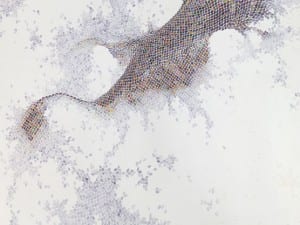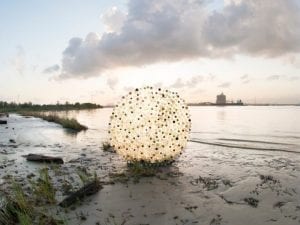Australian artist Julian Day creates simple but evocative works encompassing installation, video, sound, text and performance. His piece Requiem was shortlisted and exhibited as part of the Aesthetica Art Prize 2015 showcase at York St Mary’s earlier this year. Requiem is a self-contained sculpture suspended between two walls, and features two identical synthesisers pinned apart by metal rods. A geometric intervention, this unique installation floods the surrounding environment with a powerful sonic field. Day has previously exhibited work at the Whitechapel Gallery, London, MASS MoCA, Massachusetts, and MCA Australia in Sydney. We speak to the artist about his innovative use of sound in sculpture, and its relationship with space and architecture.
A: Requiem adapts itself to the architecture of a given space, yet disrupts the natural rhythms of its surroundings in both physical and sensory ways. What experiences do you seek to offer the viewer?
JD: One of my goals with Requiem is to activate both the ‘positive space’ occupied by the hard sculptural elements (the keyboards pinned apart by metal rods) and the ‘negative space’ that the fluid sonic elements inhabit: the invisible yet highly active sound field that surrounds you as you move about.
A: Your piece was selected for exhibition in the Aesthetica Art Prize. How has this opportunity impacted your work and outlook as an artist?
JD: I’ve been reading Aesthetica for a long time so I was thrilled to be included in both the prize and the magazine. My work was received very well, judging by the many enthusiastic comments on Post-It notes at York St Marys, and visiting in person opened a range of possible exhibiting horizons.
A: Can you describe the dynamic created in showcasing Requiem in the medieval setting of York St Mary’s? How does the venue alter the piece itself and vice-versa?
JD: I’m very specific about where my work sits. Whilst placing organs in a church has an obvious symbolism, the material factors (acoustics, placement and spatial flow) are crucial to me. I wasn’t directly involved in installing this iteration, which is unusual for me, however using such a space was ideal.
A: Requiem activates space through the droning sound of synthesisers. What inspired you to use these objects, and did you encounter any technical difficulties when making the work?
JD: I grew up in a rock household surrounded by microphones, guitars and synthesizers, and later learnt piano. So keyboards have always been around. I work with simple, light instruments in order to set up mobile ‘airspaces’ anywhere. Requiem is tricky to install as it relies on gravity, however it worked brilliantly within the context of York St Mary’s.
A: How do you see your work developing in the future, and what’s next for 2015?
JD: I’m using other musical objects as sculptural starting points, such as metronomes and loudspeakers, and creating performances and videos. I’ve just returned from London, for instance, where I directed a project for 12 historic pianos at the Royal Academy of Music. I’m now developing work for the Asia Pacific Triennial.
Visit the Julian Day’s website for more www.julianday.com
The Aesthetica Art Prize is open for entries. Register your artwork by 31 August www.aestheticamagazine.com/art-prize
Follow us on Twitter @AestheticaMag for the latest news in contemporary art and culture.
Credits
1. Julian Day, Requiem, 2012. Image copyright of the artist. Photo: Emily Sandrussi.




